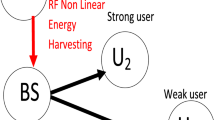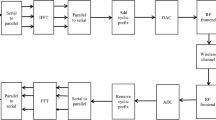Abstract
Due to time variant multipath propagation, both intersymbol interference and multiple access interference occur at CDMA receivers. These degrading effects can be combatted by joint detection (JD) techniques. In order to reduce the performance impairments resulting from time variance, coherent receiver antenna diversity (CRAD) can be used. In the present paper, a system model of CDMA mobile radio systems using various JD techniques in combination with CRAD shall be considered. This system model is an evolution of the pan-European GSM and takes important real world aspects such as imperfect channel estimation, nonlinear amplification and D/A and A/D conversion into account. The viability of JD with CRAD shall be demonstrated by bit error rate simulations of this system model. It is shown that by using JD with two receiver antennas in bad urban areas,E b/N0 < 8 dB per antenna is sufficient for a bit error rate of 10−2, andE b/N0 < 11 dB per antenna is required for a bit error rate of 10−3.
Similar content being viewed by others
Abbreviations
- AWGN:
-
Additive white Gaussian noise
- A/D:
-
Analog-to-digital
- BU:
-
Bad urban
- CDMA:
-
Code division multiple access
- COST:
-
European Co-operation in the Field of Scientific and Technical Research
- CRAD:
-
Coherent receiver antenna diversity
- cdf:
-
Cumulative distribution function
- DMF:
-
Decorrelating matched filter
- DMF-BDFE:
-
Decorrelating matched filter block decision feedback equalizer
- D/A:
-
Digital-to-analog
- EGC:
-
Equal-gain combining
- FDMA:
-
Frequency division multiple access
- GMSK:
-
Gaussian minimum shift keying
- GSM:
-
Global System for Mobile Communications
- ISI:
-
Intersymbol interference
- JD:
-
Joint detection
- JDC:
-
Japanese Digital Cellular
- JD-CDMA:
-
Joint detection code division multiple access
- MA:
-
Multiple access
- MAI:
-
Multiple access interference
- MMSE-BLE:
-
Minimum mean square error block linear equalizer
- MMSE-BDFE:
-
Minimum mean square error block decision feedback equalizer
- MRC:
-
Maximal-ratio combining
- RA:
-
Rural area
- SC:
-
Selection combining
- SNR:
-
Signal-to-noise ratio
- TDMA:
-
Time division multiple access
- TU:
-
Typical urban
- WSSUS:
-
Wide sense stationary uncorrelated scattering
- ZF-BLE:
-
Zero forcing block linear equalizer
- ZF-BDFE:
-
Zero forcing block decision feedback equalizer
References
Simon, M. K.; Omura, J. K.; Scholtz, R. A.; Levitt, B. K.:Spread spectrum communications. Vol. III, Rockville: Computer Science Press, 1985.
Baier, A.: Multi-rate DS-CDMA: A promising access technique for third-generation mobile radio systems.Proceedings of the Fourth Personal, Indoor and Mobile Radio Communications (PIMRC'93), Yokohama/Japan (1993), pp. 114–118.
Rhee, S. B. (Ed.): Special issue on digital cellular technologies.IEEE Transactions on Vehicular Technology, vol.40 (1991), no. 2.
Jung, P.; Baier, P. W.; Steil, A.: Advantages of CDMA and spread spectrum techniques over FDMA and TDMA in cellular mobile radio applications.IEEE Transactions on Vehicular Technology, vol.42 (1993), pp. 357–364.
Jung, P.; Blanz, J.: Joint detection with coherent receiver antenna diversity in CDMA mobile radio systems.IEEE Transactions on Vehicular Technology, accepted for publication.
VerdÚ, S.: Minimum probability of error for asynchronous Gaussian multiple-access channels.IEEE Transactions on Information Theory, vol.35 (1989), pp. 123–136.
Klein, A.; Kaleh, G. K.; Baier, P. W.: Equalizers for multiuser detection in code division multiple access mobile radio systems.Proceedings of the IEEE 44th Vehicular Technology Conference VTC-1994, Stockholm (1994), pp. 762–766.
Xie, Z.; Short, R. T.; Rushforth, C. K.: A family of suboptimum detectors for coherent multiuser communications.IEEE Journal on Selected Areas in Communications, vol.8 (1990), pp. 683–690.
Blanz, J.; Klein, A.; Na\han, M; Steil, A.: Performance of a cellular hybrid C/TDMA mobile radio system applying joint detection and coherent receiver antenna diversity.IEEE Journal on Selected Areas in Communications, vol.12 (1994), pp. 568–579.
Lorenz, R. W.: Vergleich der digitalen Mobilfunksysteme in Europa (GSM) und in Japan (JDC) unter besonderer Berücksichtigung der Wirtschaftlichkeitsaspekte.Der Femmelde-Ingenieur, vol.47 (1993), no. 1 & 2/93.
Steiner, B.; Jung, P.: Optimum and suboptimum channel estimation for the uplink of CDMA mobile radio systems with joint detection.European Transactions on Telecommunications and Related Technologies (ETT), Special Issue on “Multiple Access in Radio Communication Networks”, vol.5 (1994), pp. 39–50.
Jung, P.: Performance evaluation of a novel M-detector for coherent receiver antenna diversity in a GSM type mobile radio system.IEEE Journal on Selected Areas in Communications, accepted for publication.
Schwartz, M.; Bennett, W. R.; Stein, S.:Communication systems and techniques. New York: McGraw-Hill, 1966.
Höher, P.: A statistical discrete-time model for the WSSUS multipath channel.IEEE Transactions on Vehicular Technology, vol.41 (1992), pp. 461–468.
COST 207:Digital land mobile radio communications. Final report, Luxemburg: Office for Official Publications of the European Communities, 1989.
Turin, L.: Introduction to spread-spectrum antimultipath techniques and their application to urban digital radio.Proceedings of the IEEE, vol.68 (1980), pp. 328–353.
Mowbray, R. S.; Pringle, R. D.; Grant, P. M.: Increased CDMA system capacity through adaptive cochannel interference regeneration and cancellation.IEE Proceedings, Part I, vol.139 (1992), pp. 515–524.
Na\han, M.; Jung, P.; Steil, A.; Baier, P. W.: On the effects of quantization, nonlinear amplification and band-limitation in CDMA mobile radio systems using interference cancellation.Proceedings of the Fifth International Conference on Wireless Communications (Wireless'93), Calgary/Alberta, pp. 173–186.
Jung, P.: Laurent's representation of binary digital continuous phase modulated signals with modulation index 1/2 revisited.IEEE Transactions on Communications, vol.42 (1994), pp. 221–224.
Schulze, H.: Stochastische Modelle und digitale Simulation von MobilfunkkanÄlen.Kleinheubacher Berichte, vol.32 (1989), pp. 473–483.
Jakes, W. C., Editor:Microwave mobile communications. New York: Wiley, 1974.
Whalen, A. D.:Detection of signals in noise. New York: Academic Press, 1971.
Saleh, A. A. M.: Frequency-independent and frequency-dependent nonlinear models of TWT amplifiers.IEEE Transactions on Communications, vol.29 (1981), pp. 1715–1720.
Marple, S. W.:Digital spectral analysis with applications. New Jersey: Prentice Hall, 1987.
Lupas, R.; VerdÚ, S.: Near-far resistance of multiuser detectors in asynchronous channels.IEEE Trans. Commun., vol.38 (1990), pp. 496–508.
Yamada, Y.; Kagoshima, K.; Tsunekawa, K.: Diversity antennas for base and mobile stations in land mobile communication systems.IEICE Transactions on Communications, vol.E 74 (1991), pp. 3202–3209.
Proakis, J. G.:Digital communications. Second edition, New York: McGraw-Hill, 1989.
Author information
Authors and Affiliations
Rights and permissions
About this article
Cite this article
Jung, P., Blanz, J., Na\han, M. et al. Simulation of the uplink of JD-CDMA mobile radio systems with coherent receiver antenna diversity. Wireless Pers Commun 1, 61–89 (1994). https://doi.org/10.1007/BF01098505
Issue Date:
DOI: https://doi.org/10.1007/BF01098505




